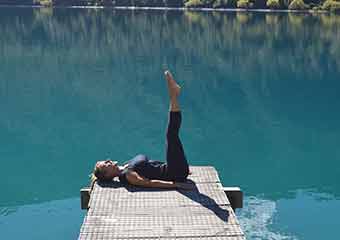
Pat Zanin
Clicking on the Send Me Details Now button opens an enquiry form where you can message Pat Zanin directly
Pilates & Yoga - Different Breathing Techniques
Servicing area
Fairy Meadow Surf Club, Elliotts Road Fairy MeadowFocus areas
Breath is essential to life. Yet, most people have no idea of how they are breathing! Yoga and Pilates bring conscious awareness to what most people consider an unconscious activity.
How to Breathe?. There are two main reasons why focus on breathing during yoga is important:
- to deepen and utilize the full capacity of the lungs
- to intensify the effects of a posture
YOGA- In yoga there are three stages of breathing. The first stage is abdominal breathing, which involves inhaling into the abdominal cavity. In order to achieve this, the diaphragm drops down and the abdomen expands, allowing the air to fill deeply into the lower lungs. The second stage of inhalation is called thoracic breathing. This stage requires the expansion of the rib cage. Think of inhaling into the back and sides of the ribs as well as the front. The third stage is clavicular breathing. Most people over-exaggerate this aspect when initially attempting to understand the movement. Place your fingertips lightly on your collar bones. Close your eyes and gently breathe normally. Feel the slight rise and fall of the collar bones as you inhale and exhale. Try not to over-exaggerate the movement by raising and lowering the shoulders. In specific yoga poses, each inhalation starts with the abdomen, then moves into the thoracic region, and finally into the clavicular region. Throughout inhalation, the muscles surrounding the lungs are actively working, and during exhalation the muscles are passive. This does not mean focus is not maintained throughout! During an exhalation, the exact reverse must be accomplished. Think of the collar bones relaxing back to their original position, and then the ribs softening, and finally the abdomen. It's very beneficial to practice abdominal/thoracic whilst performing deep static stretches, at rest or daily when we don't require lmore effort from our core musculature.
PILATES-The breath in Pilates is called Lateral, or Thoracic Breathing, in our classes we call it the "power breath" and is slightly different from the way in which breathing is performed in some yoga poses. While the process of inhalation varies, the intention is the same. In both modalities the breath dictates the movement. In Pilates, the effort of an exercise is usually done on the exhale by pulling the navel into the spine. The easiest way to explain this is to try a simple exercise. Place your hands on the sides of your rib cage with your fingertips pointing towards each other. Inhale and breathe into your hands. As you exhale, let your ribs relax. On your next inhale, think of breathing into your back and hands. On your next exhale, let your ribs fall. While performing each Pilates exercise, think of breathing fully and deeply into the sides and back of the rib cage. Joseph Pilates use to tell people to think of squeezing, every atom of impure air from your lungs in much the same manner that you would wring every drop of water from a wet cloth. Good breathing is a major component of good health, yet many of us spend our lives taking too-hallow breaths that can increase our stress levels. This type of breathing is beneficial to protect and assist the body when performing movement that require more effort. eg. bending over, picking up groceries, carrying heavy objects, twisting etc.
Click on Send Me Details Now to get started
Send Me Details Now